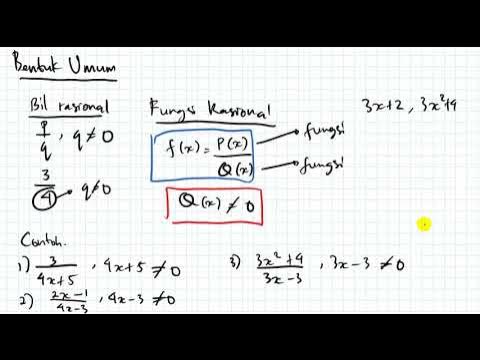Solving Rational Inequalities | TAGALOG-ENGLISH
Summary
TLDRThis video tutorial guides viewers on solving rational inequalities, a mathematical concept involving fractions where the numerator and denominator are polynomials. The presenter explains the process of finding zeros of both the numerator and denominator, and then tests intervals to determine where the inequality holds true. Examples are provided to illustrate the steps, including handling undefined expressions and ensuring the denominator is not zero. The tutorial aims to make complex mathematical problems more approachable.
Takeaways
- 📐 **Identify Critical Points**: Solve the numerator and denominator separately to find critical points where the expression is undefined or zero.
- 🔍 **Rational Inequality Form**: Rational inequalities are presented as fractions with inequality symbols, representing the relationship between the numerator and the denominator.
- 🎯 **Zero Solutions**: Set the numerator equal to zero to find the zeros, which are critical for determining the intervals to test.
- ✂️ **Interval Division**: Divide the number line into intervals based on the critical points to test the inequality within each segment.
- 📉 **Test Intervals**: Substitute test values from each interval into the inequality to determine where it holds true.
- 🚫 **Exclusion of Undefined Points**: Points that make the expression undefined (like division by zero) are excluded from the solution set.
- 🔄 **Sign Analysis**: Analyze the sign of the expression within each interval to determine if it satisfies the inequality.
- 🔢 **Substitution of Values**: Substitute specific values within each interval to test the inequality and refine the solution set.
- 🔄 **Reduction to Simpler Form**: Simplify the inequality by reducing fractions or finding the greatest common factor (GCF) to make it easier to solve.
- 📋 **Final Solution as Intervals**: Present the final solution as a set of intervals where the inequality is true, including or excluding endpoints as necessary.
Q & A
What is a rational inequality?
-A rational inequality is an inequality that involves rational expressions, which are fractions where both the numerator and the denominator are polynomials.
How do you solve a rational inequality like x + 4 over x - 1 ≤ 0?
-To solve the inequality x + 4 over x - 1 ≤ 0, you find the zeros of the numerator (x + 4 = 0) and the undefined points of the denominator (x - 1 ≠ 0), then test intervals between these points to see where the inequality holds true.
What are the zeros of the numerator and the undefined points of the denominator for the inequality x + 4 over x - 1 ≤ 0?
-The zero of the numerator is x = -4, and the undefined point of the denominator is x = 1.
How do you test the intervals for the inequality x + 4 over x - 1 ≤ 0?
-You test the intervals (-∞, -4], (-4, 1), and (1, ∞) by substituting values from each interval into the inequality and checking if it holds true.
What is the solution to the inequality x + 4 over x - 1 ≤ 0?
-The solution to the inequality x + 4 over x - 1 ≤ 0 is the interval [-4, 1), where -4 is included and 1 is not included.
How do you handle a rational inequality where the inequality sign is '>' instead of '≤'?
-When the inequality sign is '>', you look for intervals where the rational expression is positive instead of non-negative.
What is the process of finding the solution to a rational inequality with a quadratic numerator?
-For a rational inequality with a quadratic numerator, you find the zeros of both the numerator and the denominator, consider the undefined points, and test the resulting intervals to find where the inequality holds.
Can you give an example of solving a rational inequality with a quadratic numerator?
-Sure, for the inequality x^2 + 3x over 2x - 1 > 0, you would find the zeros of x^2 + 3x = 0 and 2x - 1 ≠ 0, then test the intervals between these points to find where the expression is positive.
What are the steps to solve a rational inequality with a compound expression like 1/(x - 3) ≤ 5/(x - 3)?
-First, simplify the compound expression to a single rational inequality, then find the zeros and undefined points, and test the intervals to find where the inequality holds.
How do you determine the intervals to test for a rational inequality?
-The intervals to test are determined by the zeros of the numerator and the values that make the denominator zero or undefined. These points divide the number line into intervals to be tested.
What is the significance of including or excluding certain points in the solution set of a rational inequality?
-Points are included in the solution set if the inequality holds true at those points, and excluded if the inequality does not hold. This is determined by testing values within the intervals and at the boundaries.
Outlines

Этот раздел доступен только подписчикам платных тарифов. Пожалуйста, перейдите на платный тариф для доступа.
Перейти на платный тарифMindmap

Этот раздел доступен только подписчикам платных тарифов. Пожалуйста, перейдите на платный тариф для доступа.
Перейти на платный тарифKeywords

Этот раздел доступен только подписчикам платных тарифов. Пожалуйста, перейдите на платный тариф для доступа.
Перейти на платный тарифHighlights

Этот раздел доступен только подписчикам платных тарифов. Пожалуйста, перейдите на платный тариф для доступа.
Перейти на платный тарифTranscripts

Этот раздел доступен только подписчикам платных тарифов. Пожалуйста, перейдите на платный тариф для доступа.
Перейти на платный тариф5.0 / 5 (0 votes)






